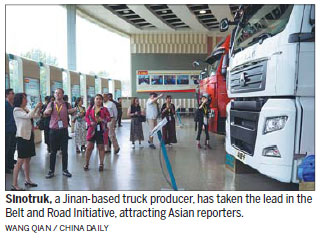Province seizes opportunities of the Belt and Road Initiative
East China's Shandong province is playing a pivotal role in implementing the country's Belt and Road Initiative.
The province is targeting the marine economy, industrial upgrade, transport facilities, energy and resources, said Liang Wenyue, deputy director, regional integration promotion office under the Shandong Development and Reform Commission.
The province aims to become the nation's modern logistics hub and a center for marine economic cooperation, international industrial upgrades and human exchange as well as a regional cooperation center along the Belt and Road routes.
To this end, the province has established a leading group to coordinate involvement in the B&R Initiative and issued a series of government policies to strengthen customs services, quality supervision, inspection and quarantine.
Nine cities in the province have implemented B&R action plans.
Since the initiative was announced three years ago, the province has seen its international trade with countries involved in the B&R surge significantly.
In 2016, foreign trade with those countries reached 413.4 billion yuan ($60.7 billion), up 8.4 percent, and accounted for 26.7 percent of the province's overall foreign trade.
Eight industrial parks have been set up along the B&R routes, including four national-level trade cooperation zones in Pakistan, Hungary and Russia.
The province's investment in B&R projects reached 29.42 billion yuan, accounting for 16.7 percent of the province's total foreign investment.
Turnover of contracted projects hit 42.59 billion yuan, up 45 percent year-on-year.
Qingdao-based Haier Group invested in and built household electrical appliance manufacturing enterprises in Pakistan.
Jining-based Ruyi joined hands with State-owned Huaneng Group to build a coal-fired power station in Sahiwal, Pakistan, a highlight along the China-Pakistan Economic Corridor.
Some breakthroughs have also been made in establishing transport connections, Liang said.
To date, 279 trains transited between Europe and Asia and rail freight handled by railways reached 299,000 tons last year, up 162.8 percent and 128.8 percent year-on-year, respectively.
To date, 31 container trains combining ocean and railway transportation have been set up in the province.
The Qingdao B&R cross-border container inter-model transport project has been incorporated into China's first batch of 16 inter-model transportation demonstration projects.
The province aims to make further headway in B&R construction, Liang said.
It is committed to building the East Asia Marine Platform, which has become a key part of the "10 plus 3" marine cooperation network covering ASEAN members and three countries including China, Japan and South Korea.
In terms of cultural cooperation, Shandong has cooperated with 47 cities in 23 countries, and established friendly cooperative relations with 31 cities in 14 countries.
It has supported overseas Confucius Institutes and 28 Confucius classrooms, boosting the culture of Confucius - who was born in Shandong - worldwide.
Global presence
Local companies in Shandong have taken the lead in China in their forays into the B&R markets.
One of China's top heavy vehicle manufacturers, Sinotruk, has vowed to keep forging new paths into the international market along the Belt and Road routes, according to a senior spokesperson at the company.
The comments were made by Li Gonghai to reporters from South, Southeast and Central Asia during a fact-finding trip and a tour of the manufacturer's headquarters and production line in Jinan, capital city of Shandong province, on July 4.
Li said that Sinotruk is making great strides into overseas markets, particularly in the emerging economies of Central Asia, Africa, the Middle East and South America.
In Central Asia alone, since 2011, the company has sold more than 8,000 heavy duty trucks in Kazakhstan, exported some 2,000 vehicles to Uzbekistan, and more than 3,000 of its HOWO heavy trucks are currently used in Turkmenistan.
Apart from vehicle sales and exports to Central Asia, Sinotruk also wants to develop local assembly lines in the region, particularly in Kazakhstan. The company is currently working to establish the assembly lines, with a memorandum of understanding signed by Chinese Premier Li Keqiang and Kazakhstan's Prime Minister Bakhytzhan Sagintayev during a visit to the oil-rich nation in December 2014.
Another B&R pioneer in Shandong is the Jinan-based Linuo Group, which has become the world's leading solar energy group.
Tubes produced by the group account for 65 percent of the country's total and 90 percent of its photovoltaic products have been exported overseas.
Its exports hit 800 million yuan in 2016 to more than 100 countries and regions.
Zhang Beiwen, the company's vice-president, indicated that China, the United States and India are the major consumers of solar energy, while Southeast Asian countries are sufficient in solar energy.
"Linuo's product presence in B&R countries is facing challenges from their national governments failing to support solar energy. To help boost their solar energy and reduce traditional power use, we expect overseas countries to issue more preferential policies to boost the market."
Owen Fishwick and Yang Min contributed to the story.

(China Daily 07/14/2017 page12)














